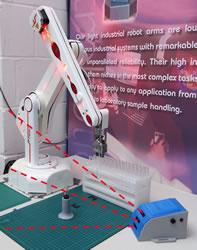Markets tend to fluctuate, for example we have not had much interest from the pharmaceutical world in recent years. However there has been a big increase in the use of robots for product testing.
 RoboticsTomorrow - Catching up with David Sands of ST Robotics
RoboticsTomorrow - Catching up with David Sands of ST Robotics

David Sands | ST Robotics
Tell Us About ST Robotics
ST aims to provide robots that are affordable, easy to set up and use and easily programmed by any individual regardless of experience. We provide free and unlimited support throughout the learning curve. We equally aim to provide a low cost solution to experienced users for a diverse range of advanced or complex tasks. Some users manage with our acclaimed manuals, some need more support and advice. It's what we do.
We spoke with you in 2014 when you spoke about the company and markets served. In the 4 years since, the Robotics industry has seen rapid growth and change. Tell us about ST Robotics now and how the company has evolved.
ST has always been market led and customer requirements have driven our technical developments. Since 2014 we have added 20 new accessories all because of customer demand. For example our R12 robot arm is a real industrial arm but scaled down so it was not possible to fit standard industrial tool changers. ST designed an innovative miniature tool change system that is entirely passive, requiring no pneumatics or electrics. More recently we have responded to the huge interest in collaborative robotics. Skeptical of how some robot companies handle safety ST have designed a "workspace sentry" system that guards the collaborative workspace and stops the robot if anyone or anything intrudes into the space. We are now working on a capacitive system that will stop the robot if a human hand merely gets near the robot regardless of where it is
Where have you seen the most growth in the company the last few years?
Markets tend to fluctuate, for example we have not had much interest from the pharmaceutical world in recent years. However there has been a big increase in the use of robots for product testing.
What is it that you feel sets ST Robotics products apart from others?
We have always believed in the "boxed robot" concept. Unpack it, set it up and go. Simplicity equals reliability so we keep them simple. The simplicity also results in ease of use. Users with no technical background at all can get going with our software in which the user has a kind of conversation with the robot. In fact we even had a speech input facility so the robot literally does what it is told! Then we follow up with unlimited free technical support.
You are currently seeking distributors for your product, tell us about that.
Although we are mostly Internet based there are many customers who prefer to contact a local distributor. This is especially true if they want the system installed along with other equipment so we have found integrators to be very useful. We are seeking distributors and integrators around the world and not just the USA.
Where do you see ST Robotics and Robotics in general 5 or 10 years down the road?
We see a few serious growth markets in agriculture. We are currently collaborating with some companies who will access this huge market by licensing our technology. Simplicity and reliability are essential in this field. We are also collaborating with universities to bring more innovation ideas into the company. In 5-10 years ST will still be selling low cost robots along with its extensive range of accessories but also heavily involved in new markets such as agriculture, vending and many other specialized applications.
ST Robotics Develops the Workspace Sentry for Collaborative Robotics
 The ST Robotics Workspace Sentry robot and area safety system are based on a small module that sends an infrared beam across the workspace. If the user puts his hand (or any other object) in the workspace, the robot stops using programmable emergency deceleration. Each module has three beams at different angles and the distance a beam reaches is adjustable. Two or more modules can be daisy chained to watch a wider area. "A robot that is tuned to stop on impact may not be safe. Robots where the trip torque can be set at low thresholds are too slow for any practical industrial application. The best system is where the work area has proximity detectors so the robot stops before impact and that is the approach ST Robotics has taken," states President and CEO of ST Robotics David Sands.
The ST Robotics Workspace Sentry robot and area safety system are based on a small module that sends an infrared beam across the workspace. If the user puts his hand (or any other object) in the workspace, the robot stops using programmable emergency deceleration. Each module has three beams at different angles and the distance a beam reaches is adjustable. Two or more modules can be daisy chained to watch a wider area. "A robot that is tuned to stop on impact may not be safe. Robots where the trip torque can be set at low thresholds are too slow for any practical industrial application. The best system is where the work area has proximity detectors so the robot stops before impact and that is the approach ST Robotics has taken," states President and CEO of ST Robotics David Sands.
The content & opinions in this article are the author’s and do not necessarily represent the views of RoboticsTomorrow
Comments (0)
This post does not have any comments. Be the first to leave a comment below.
Featured Product

